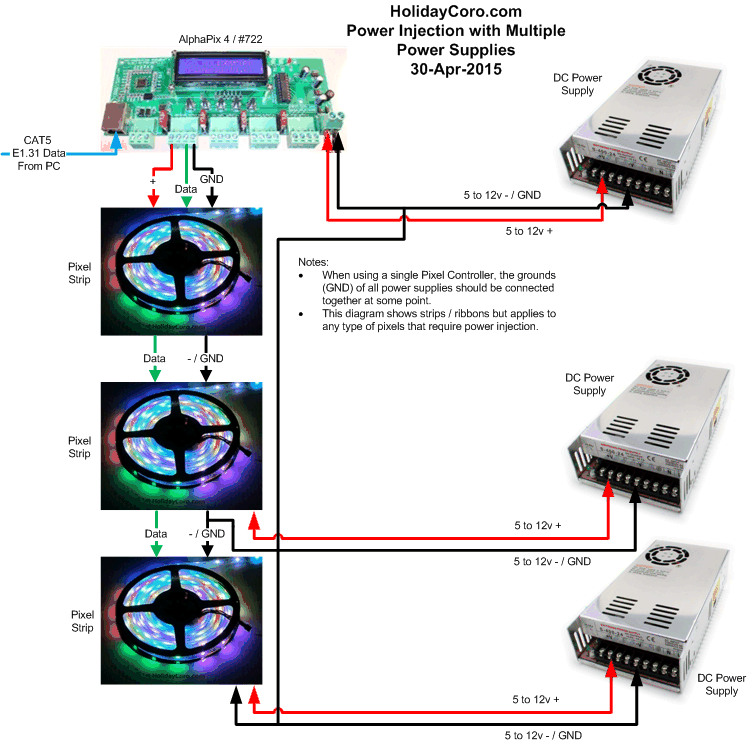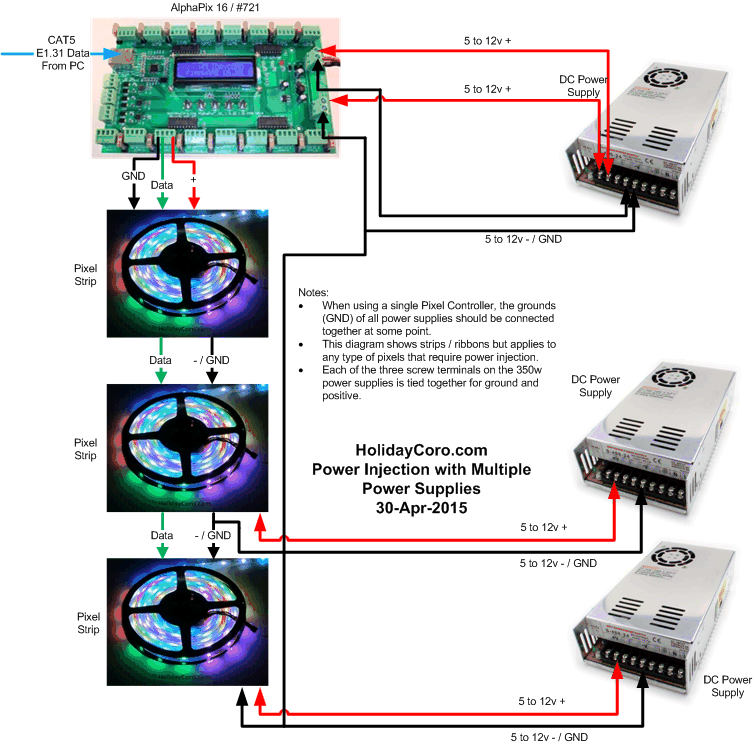A very common question we get at HolidayCoro is - which voltage should I use for my project. While there are often not many absolutes, this article works to cover many of the factors you should be considering when selecting a voltage for a project.
First and foremost, you MUST select the physical format (nodes, bulb, strip, etc) and define the design BEFORE you pick the voltage because the number of pixels and their physical orientation drives most of the decision for the voltage used. For an overview of the entire proper design process, see this blog post: http://blog.holidaycoro.com/2015/01/where-do-i-start-when-designing-new-rgb.html
First, a few basics:
- LED Voltages - Individual LEDs are not driven at voltages of 5v or 12v but at voltages around 1.7 to 2.0 volts - mainly depending on the color output type and LED component construction. This means that the incoming power must be reduced down to the LED's operating voltage.
- Inefficiency - The problem with dropping voltage from say, 12v to 5v is that it is inefficient - this is why if you hold a 12v pixel string or strip, you'll notice a lot of heat compared to a comparable product type of 5 volts. That additional heat comes from the dropping resistors that are used to reduce the 12v down to around 5v.
- LED Brightness - In a given string of lights, the 5v and 12v string of lights will have the same level of brightness - so there is NO advantage to go with 12v just for light output (lumens). For example, a 50 count string of RGB nodes will consume about 27 watts of power at 12v and that same string in 5v will consume 15 watts with the exact same level of output and in fact, normally have the exact same LEDs for both 5v and 12v strings.
- Distance - THE primary reason for using 12v over 5v is going to be in most cases, distance. For the same reason that power comes to your house at voltages well above 120 volts (10,000 or more is common), is the same reason 12v has an advantage over 5v. See the rules of thumb below.
- Rules Of Thumb
- A large driver of how many lights can be driven is based on the quality of output required for the design. Since RGB lights use the most power when displaying white which is a combination of all three colors (red, green, blue), if your display / sequence doesn't use all white or uses only partial white output on the string, you often can get away with not having to design for the maximum output of "all white".
- 5V Node String of 50 count (Bullet and Square)
- Excellent Quality Output - Generally 50 nodes
- Good Quality Output - Generally 75 nodes
- Low or minimal white Output - Generally 100 nodes
- 12v Node String of 50 count (Bullet and Square)
- Excellent Quality Output - Generally 100 nodes
- Good Quality Output - Generally 125 nodes
- Low or minimal white Output - Generally 150 nodes
- Power Injection - As power runs down the length of lights, it is used up and eventually it needs to "injected" again. This can be from the original power source that feeds the start of the string or from another power source independent from the initial power source. See the diagram below for examples of how power injection works from multiple power supplies.
- 12v Strips - You may notice that strips are often a ratio of 3 LEDs to 1 pixel (30/10, 48/16, 60/20) and there is a good reason for this. To make strips more efficient, each of those LEDs is run in series, so instead of dropping the voltage from 12v down to around 2v, the voltage only drops to around 6v (2v + 2v + 2v) and thus are more efficient. This is how legacy LED light strings (non-RGB) work - just on a larger scale of 70 LEDs (70 LEDs * 1.7 volts = 120v). The exception here is 30/30 and 60/60 strips which either run directly from 5v (uncommon) or via "buck converters" that drop the voltage from 12v to 5v all along the strip. This is why a 30/10 strip will typically use less power than a 30/30 strip.
Here are some very broad assumptions for voltages used in common projects:
- Matrix panels using nodes
- Since the pixels are generally tightly spaced (2" to 4"), power loss is kept to a minimum and runs, even if they are long, zig zag back and forth making power injection easier.
- Matrix panels often use 5v
- There are MANY factors to consider that vary from design to design
- House outlines using nodes, bulbs and strips
- Nearly universally 12v due to the long, linear runs
- MegaTrees
- Strip Trees - Nearly always 12v
- Node Trees - Under 70 nodes per string often make sense with 5v, larger trees with 100+ nodes per run are usually 12v
- Arches
This diagram shows how power injection works from a AlphaPix controllers using multiple power supplies:


|